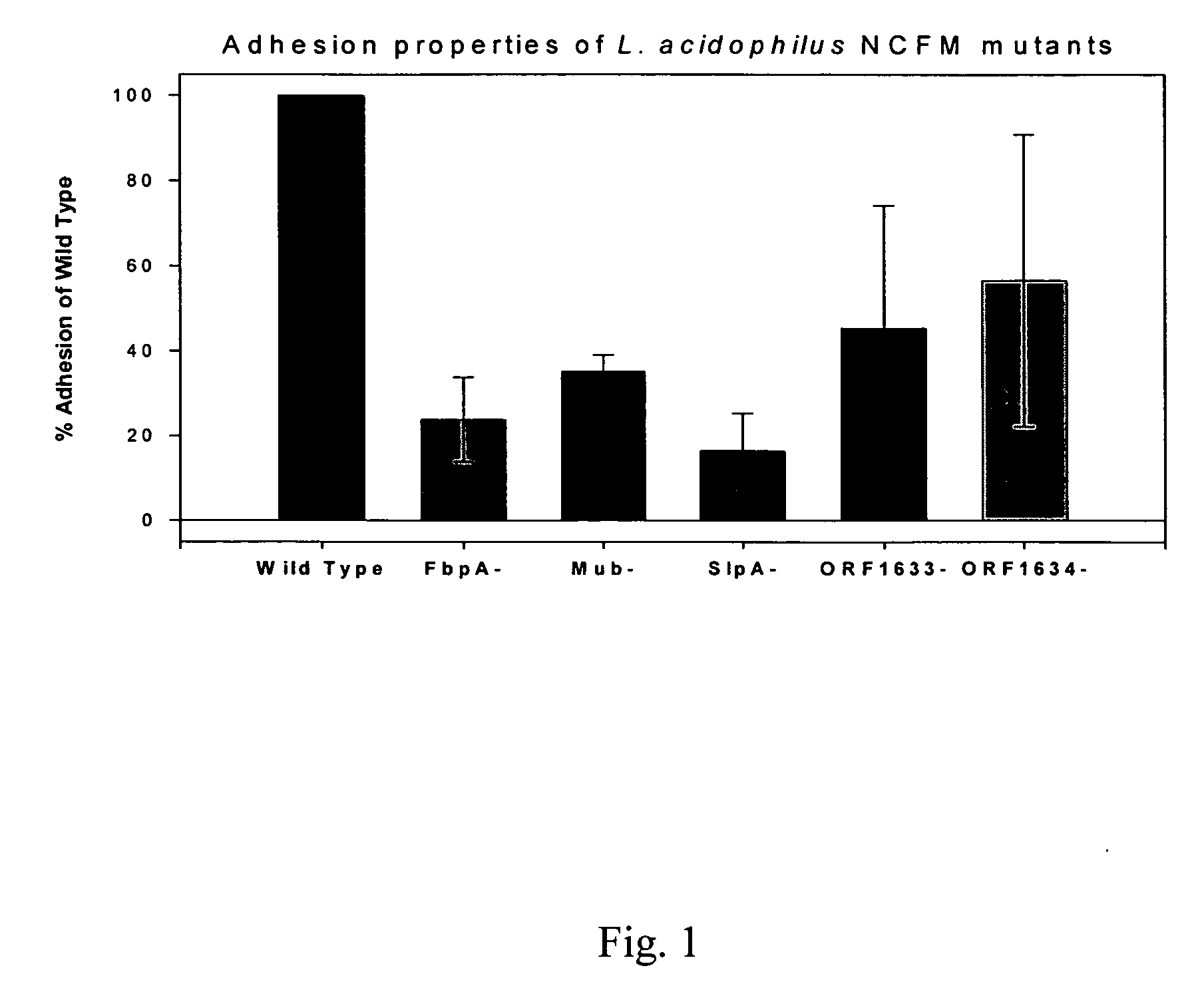Lactobacillus acidophilus nucleic acid sequences encoding cell surface protein homologues and uses therefore
a technology of lactic acid bacteria and nucleic acid sequences, which is applied in the field of polynucleotides isolated from lactic acid bacteria, can solve the problems of interfering with the growth of undesirable bacteria, pathogens, yeasts, etc., and achieves the effect of enhancing the stability of microorganisms expressing and promoting growth
- Summary
- Abstract
- Description
- Claims
- Application Information
AI Technical Summary
Benefits of technology
Problems solved by technology
Method used
Image
Examples
example 1
Gapped BlastP Results for Amino Acid Sequences
[0167] A Gapped BlastP amino acid sequence alignment showed that SEQ ID NO:2 (306 amino acids) has about 73% identity from amino acids 7-304 with a protein from Lactobacillus gasseri that is a ABC-type metal ion transport system, periplasmic component / surface adhesin (Accession No. ZP—00046648.1), about 71% identity from amino acids 9-304 with a protein from Lactobacillus johnsonii that is an ABC transporter solute-binding component (Accession No. NP—965678.1), about 62% identity from amino acids 18-306 with a protein from Lactobacillus gasseri that is an ABC-type metal ion transport system, periplasmic component / surface adhesin (Accession No. ZP—00046208.1), about 62% identity from amino acids 26-306 with a hypothetical protein from Lactobacillus johnsonii (Accession No. NP—964756.1), and about 45% identity from amino acids 18-306 with a protein from Leuconostoc mesenteroides subsp. mesenteroides that is an ABC-type metal ion transport...
example 2
PFAM Results for Amino Acid Sequences
[0319] SEQ ID NO:2 contains a predicted Lipoprotein—4 domain located from about amino acids 25 to 306, and is a member of the Periplasmic solute binding protein family (SBP_bac—9)(PFAM Accession PF01297).
[0320] SEQ ID NO:10 contains a predicted Glyco_hydro—32 domain located from about amino acids 24 to 409, and is a member of the Glycosyl hydrolases family 32 (Glyco_hydro—32)(PFAM Accession PF00251).
[0321] SEQ ID NO:62 contains a predicted SLAP domain located from about amino acids 1 to 456, and is a member of the Bacterial surface layer protein family (SLAP) (PFAM Accession PF03217).
[0322] SEQ ID NO:82 contains a predicted Amidase—2 domain located from about amino acids 59 to 208, and is a member of the N-acetylmuramoyl-L-alanine amidase (Amidase—2) family (PFAM Accession PF01510).
[0323] SEQ ID NO:92 contains a predicted FTSW_RODA_SPOVE domain located from about amino acids 15 to 388, and is a member of the Cell cycle protein family (FTSW_R...
example 3
Identification of Sequences Involved in Cell Adhesion
[0381] The ability of microorganisms to adhere to mucosal surfaces can provide a distinct advantage when establishing residence in the gastrointestinal tract. Lactobacilli are normal components of the intestinal microbiota, although the molecular mechanisms by which these organisms attach to the epithelium have not yet been fully characterized. In order to identify genes potentially involved with adhesion in L. acidophilus NCFM, the complete genomic sequence was analyzed and open reading frames (ORFs) similar to genes previously shown to be involved with adhesion were selected, including two streptococcal R28 homologs (SEQ ID NO:76 and SEQ ID NO:78, designated as ORF 1633 and ORF 1634, respectively in FIG. 1), a fibronectin binding protein (FpbA)(SEQ ID NO:58), and a mucin binding protein (Mub) (SEQ ID NO:18). To determine their impact on adhesion, these genes were targeted for insertional inactivation using the integration tools...
PUM
| Property | Measurement | Unit |
|---|---|---|
| temperature | aaaaa | aaaaa |
| temperature | aaaaa | aaaaa |
| pH | aaaaa | aaaaa |
Abstract
Description
Claims
Application Information
 Login to View More
Login to View More - R&D
- Intellectual Property
- Life Sciences
- Materials
- Tech Scout
- Unparalleled Data Quality
- Higher Quality Content
- 60% Fewer Hallucinations
Browse by: Latest US Patents, China's latest patents, Technical Efficacy Thesaurus, Application Domain, Technology Topic, Popular Technical Reports.
© 2025 PatSnap. All rights reserved.Legal|Privacy policy|Modern Slavery Act Transparency Statement|Sitemap|About US| Contact US: help@patsnap.com

